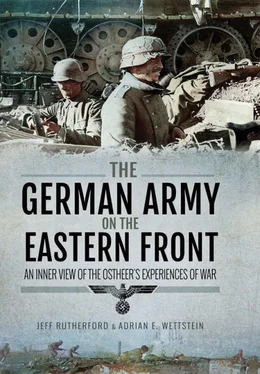B) Staff
Of the 12 men sent, 7 are trained with horses as drivers for the wagon-driver’s seat or on the saddle. These, as well as a further 3 men, are not trained on the heavy infantry gun. None of the men were briefed on the heavy infantry gun on the assault gun. All tank drivers without experience. Driving license exam was done the day before the departure.
2) Assault Gun Battalion 244
A) Guns
Operating instructions and ballistic tables are missing.
B) Staff
The men who were sent along had been commanded by the replacement battalion for three days in the factory where the guns were made. They are neither trained on driving the assault gun chassis nor on the gun.
The troops of the LIst Army Corps that fought their way through the rubble-filled streets in Stalingrad desperately awaited new weapons that combined high mobility and firepower, especially as their time for attack was running out in November 1942 due to the need to save troops to counter the expected Soviet winter offensives. An efficient deployment of those weapons was hindered by several issues, including the failure to properly maintain old chassis, crews that were either poorly trained in the use of the weapons or were inexperienced, and the lack of vital equipment. Even if they had arrived in early November, they could never have been a game-changer, as the larger context of the German attack on Stalingrad – and the Soviet response – did not allow for German victory at that time.
The introduction of completely new weapon systems under wartime conditions provided an even stiffer challenge to the military system. An excellent example of this phenomenon can be seen in the case of the ‘ Sturmgewehr ’ (Assault Rifle) 44, which proved revolutionary in infantry armament as it combined the long-range precision of a rifle with the short-range firepower of the submachine gun. Hitler was opposed to such a weapon for a long time, but he was not alone, as is often claimed in literature. Many of the army’s central agencies feared a loss of fire discipline, which would necessarily lead to a higher consumption of ammunition. The new weapon would result in the introduction of a new type of rifle ammunition, further complicating the supply system. Following early tests in 1943, the infantry branch urgently demanded that the weapon be put into production. Two waves of large combat tests were carried out in spring and autumn 1944, before the weapon was finally put in service in December 1944. [15]The following source is the evaluation report given by the 1st Infantry Division in autumn 1944. Typically, the evaluation report was written in response to a questionnaire: [16]
I) Structure
1) Has the concentration of the snipers in the company headquarters of the Grenadier companies proven itself? How was the deployment of the snipers carried out?
Concentration of the snipers in the submachine gun (SMG) company has fully proven itself. In the defence , the deployment of snipers (in each case a sniper and an observer) in the centre of gravity is advisable. Deployment by individual groups is a proven failure, since this often results in sentry service. The deployment of snipers inside the company sector must be mobile . In the attack, the sniper group remains with the company leader as a reserve for deployment at the appearance of enemy snipers and individual targets difficult to distinguish.
2) How effective has the merging of the light machine gun squad and the rifle grenade squad in one group of the platoon been: a) from the point of view of the platoon leader? b) from the point of view of the group leader?
To a) The merging of the light machine gun squad and the rifle grenade squad in one group under the command of the platoon leader has proven itself effective. In the attack, the group is with the platoon leader, the light machine gun follows during the attack behind the advancing SMG groups. When meeting fierce resistance and at the shift to defence, the light machine gun squad will be deployed by the platoon leader and strengthen the defensive power of the SMG groups, which by then have frequently depleted their ammunition .
The complete rifle grenade squad will also be tasked by the platoon leader against enemy targets under cover. It is easier for the rifle grenade riflemen to supply themselves from the following infantry cart when completely deployed than when individually attached to groups. It is advised that the leader of the machine gun and rifle grenade squad [should be] the deputy platoon leader.
To b) Such an arrangement is solely a relief for the group leader . The few available good group leaders were tasked with leading the mixed groups. For the average and poor group leaders, which are the majority, the leadership of a group which consists of only one [type of] weapon is simplified.
3) Has the structure of the SMG group proven itself? Did the firepower also suffice in the defence?
The structure of the SMG group has fully proven itself. Leadership and training with only one [type of] weapon is simplified. A SMG group is more agile in counterthrusts than previous riflemen group. The firepower of a SMG group is also sufficient in the defensive.
In what was typical for the German approach to warfare, the first questions addressed did not concern technical points, but rather tactical ones, i.e. how to structure the groups and platoons to most fully exploit the available firepower. This also included the question of leadership, a pressing issue in the later war years, as experienced and well-trained leaders on the lower levels were increasingly in short supply. The central question above in structure and command was about how best to integrate the fire elements (light machine gun, rifle grenade, snipers) into small units. In the 1930s, the German rifle group used rifles, one or two submachine guns, a light machine gun for fire support and an anti-tank rifle. This could be handled by an NCO. This set of weapons rapidly expanded from 1942 on, as rifle grenades, semi-automatic rifles, rifles with telescopic sights, and, eventually, automatic rifles and the Panzerfaust were introduced. Captured weapons further complicated the situation. A group with this set of weapons proved too difficult to be effectively trained and commanded by NCOs, especially as the level of training decreased during the course of the war. As a result, fire elements on the platoon level were concentrated in one special group, while the regular infantry was equipped as uniformly as possible, ideally with the Assault Rifle 44. [17]
II) Combat Power
1) How is the gain of the infantry’s combat power with the introduction of the SMG 44 evaluated?
Combat power and mobility of the infantry was substantially enhanced by the refitting with SMG 44. Combat power does not suffer as much through the loss of an individual SMG 44 as by the corresponding loss of rifles in the old riflemen group.
In the defence , the SMG ensured targeted single shots up to 600m and a dense fire curtain on close range. With only a medium use of ammunition, the SMG provides the particular counterthrust momentum through the extraordinary moral effect of full-automatic fire. The same is true for the attack of the SMG company.
The SMG group has especially proven itself effective in the woods and bush terrain.
The experiences of the recent battles in the south have shown that night attacks could be carried out with particular success and with few losses through the mass deployment of the SMG 44. These night attacks allowed for a relatively easy breakthroughs against strong enemy ATG and heavy weapons frontlines, against which attacks during the day seemed hopeless.
[…]
2) Should it be considered necessary to completely outfit the other units of the Grenadier regiment (except the Grenadier companies) with the SMG? For which units and [individual] soldiers would the arming with the rifle 98k suffice, when applying a sharp standard?
Читать дальше






![John Stieber - Against the Odds - Survival on the Russian Front 1944-1945 [2nd Edition]](/books/405234/john-stieber-against-the-odds-survival-on-the-russian-front-1944-1945-2nd-edition-thumb.webp)





